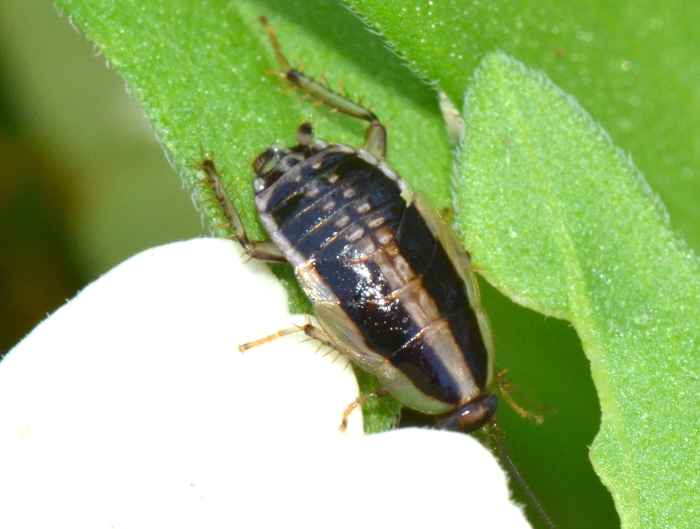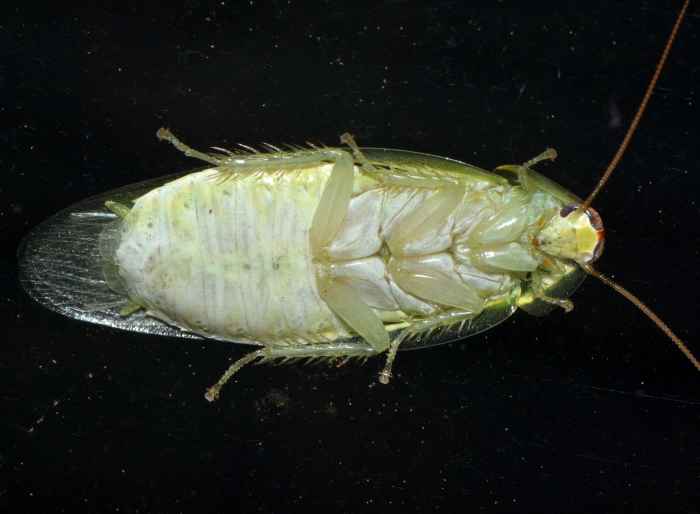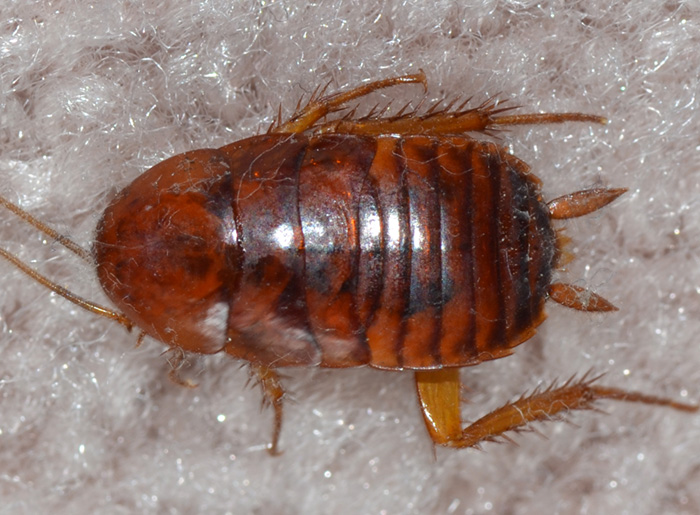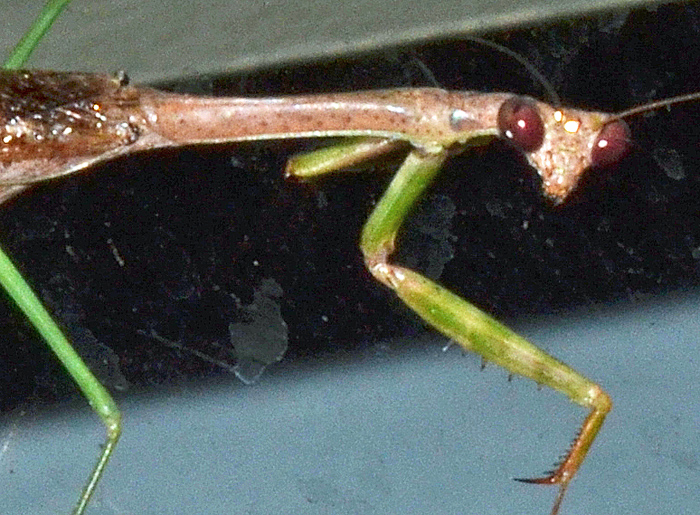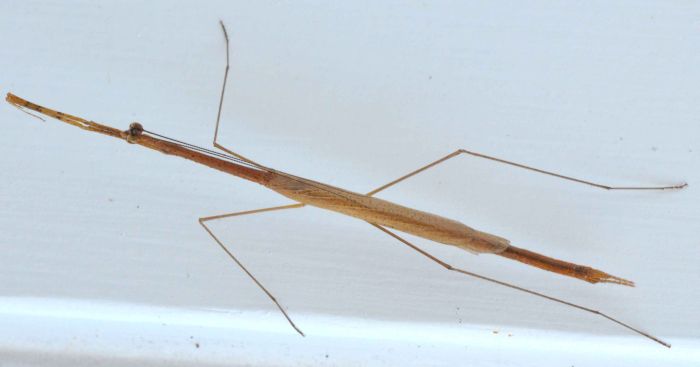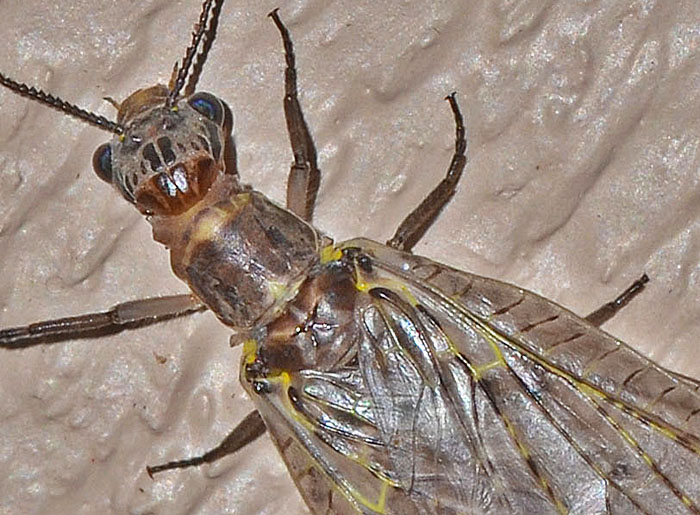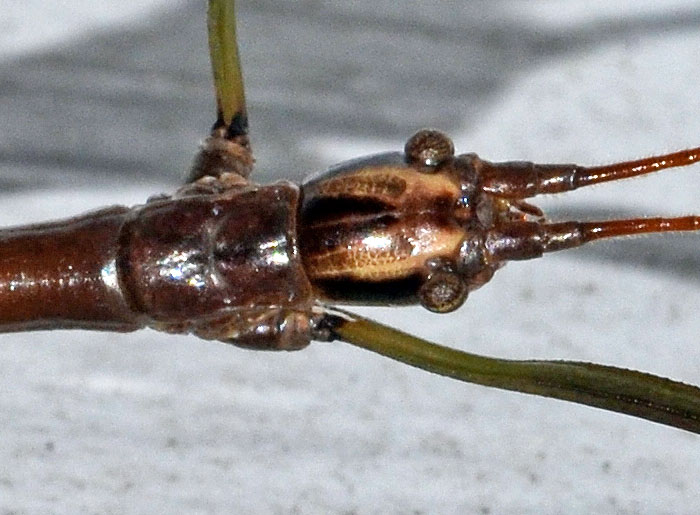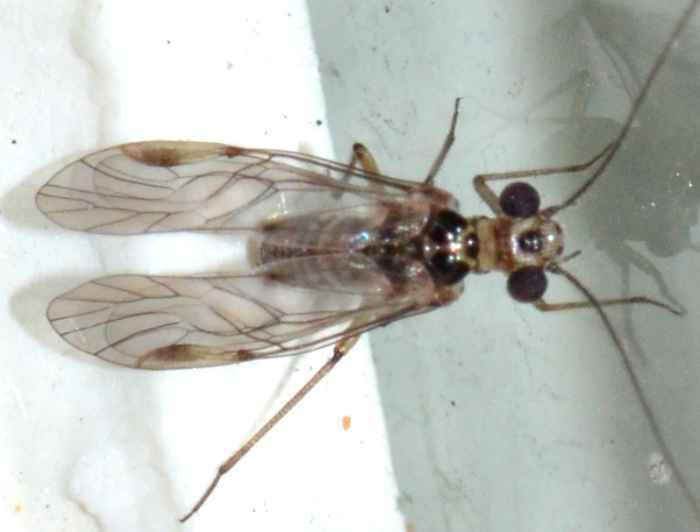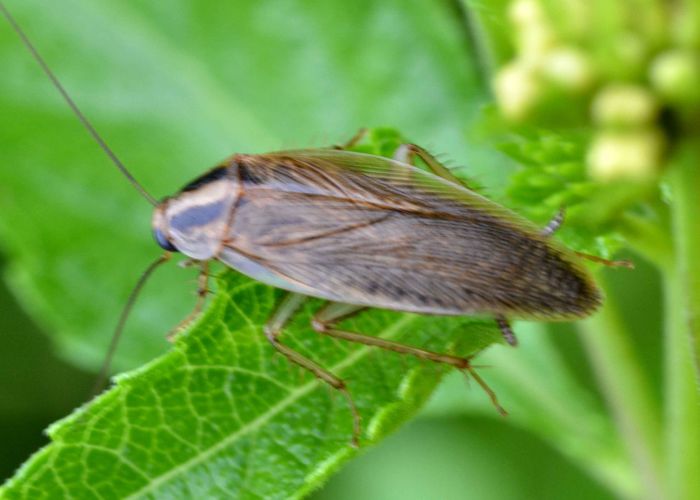 Blatella asahinai (germanica?) (Asian Cockroach). | German and Asian Cockroaches are difficult to distinguish and can hybridize. However they differ in behavior. Nymphs (small photo) of the Asian species live in ground cover etc.; adults readily fly and are most active at the beginning of sunset. In the US, B. asahinai was first reported in 1986 but has become common in Florida.
bug guide: http://bugguide.net/node/view/33854 bug guide (small photo): http://bugguide.net/node/view/565829 G. Mullen et al. Med. Vet. Entomol., pp. 47: http://alturl.com/zbc67 | ||
 Panchlora nivea (Green Banana Cockroach). | I had never seen a green cockroach before! This is Panchlora nivea (Green Banana Cockroach, also known as Cuban Cockroach). Their are acitve at night and seem to be attracted to light. They do not breed indoors and are native to Cuba where they are presumably found on bananas. Please have a look at the left, small photo (click to enlarge). It shows a great view of the roach's bottom side.
bug guide (these photos): http://bugguide.net/node/view/688074 | ||
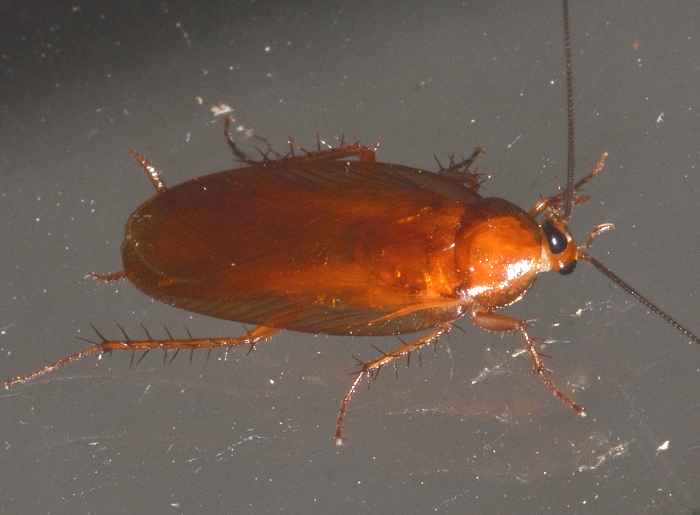 Parcoblatta sp. (Wood Cockroaches). | Wood Roaches have twelve species in our area and only males can be further identified by dissection since the characteristic features are covered by the wings. The bugguide states that "indoors, they wander aimlessly during the day (rather than congregating in a particular room and being active at night), do not breed, and will die within a few days due to insufficient moisture."
bug guide (this photo): http://bugguide.net/node/view/684947 | ||
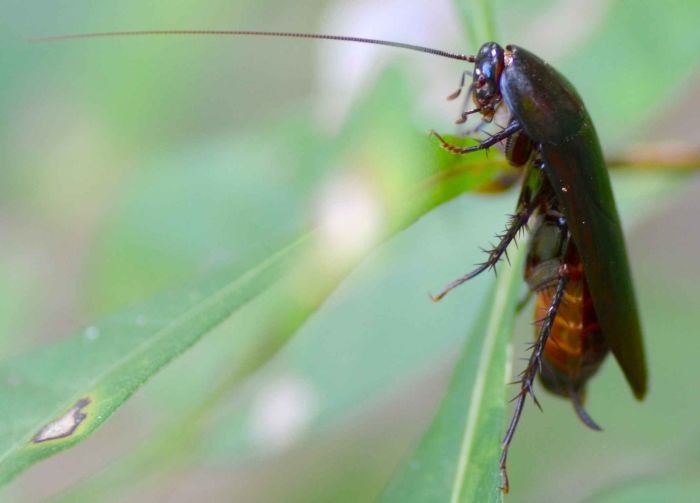 Periplaneta fuliginosa (Smoky Brown Cockroach). | This rather large insect is a Smoky Brown Cockroach (Periplaneta fuliginosa). The roach has very long antennae and a rather uniform (very dark and shiny) color. The Smoky Brown Cockroach requires moist conditions and is typically found in leave litter, pine straw, tree holes etc. They are able fliers and can become a pest in houses but are more likely to be found in attics, garages etc. Their forage radius is about 30 m. The larger American Cockroach is in the same genus. The small photo was taken in May 2019.
bug guide: http://bugguide.net/node/view/115161 G. Mullen et al. Medical & Veterinary Entomology, p. 46.: http://tinyurl.com/medvetbook | ||
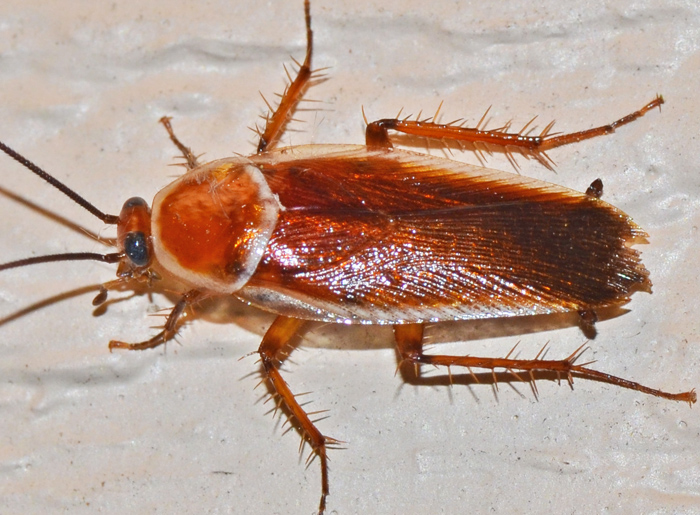 Pseudomops septentrionalis | The Pale Bordered Field Cockroach arrived in Florida within the last years but has been reported in Mississippi since 1987. The species entered the US from Mexico. It prefers low-growing herbaceous vegetation and seemingly does not infest houses. On occasion it visits flowers. This specimen was attracted by our porch lights.
bug guide (this photo): http://bugguide.net/node/view/1249856 Miami News Times: http://tinyurl.com/miami-new-times-2015 N. M. Schiff, T. L. Schiefer, Entomol. News 110, 240, 1990: http://www.srs.fs.usda.gov/pubs/ja/ja_schiff003.pdf | ||
 Doru taeniatum (Lined Earwig) ♂. | This earwig is Doru taeniatum. It lives on grasses, flies easily, and is attracted to light. There are apparently three species of Doru in North America. The small photo (08/18/14) below shows female of D. taeniatum
bug guide (large photo): http://bugguide.net/node/view/688747 P. M. Choate (modified from Hoffman, 1987) The Order Dermaptera (Earwigs) in Florida and the United States: http://entnemdept.ifas.ufl.edu/choate/dermaptera.pdf | ||
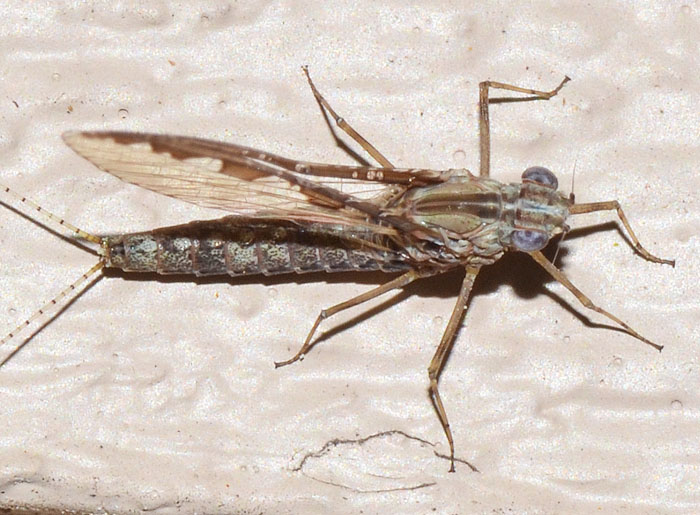 Callibaetis pretiosus. | This mayfly is Callibaetis pretiosus. There are 12 US species in this genus. They are highly tolerant of ecological extremes. Female imagoes usually have intensely colored leading edges of their forewings. Lots of interesting information on this very important mayfly can be found via the flyfishing link.
bug guide (this photo): http://bugguide.net/node/view/1199082 California School of Flyfishing: http://www.flyline.com/entomology/callibaetis/ | ||
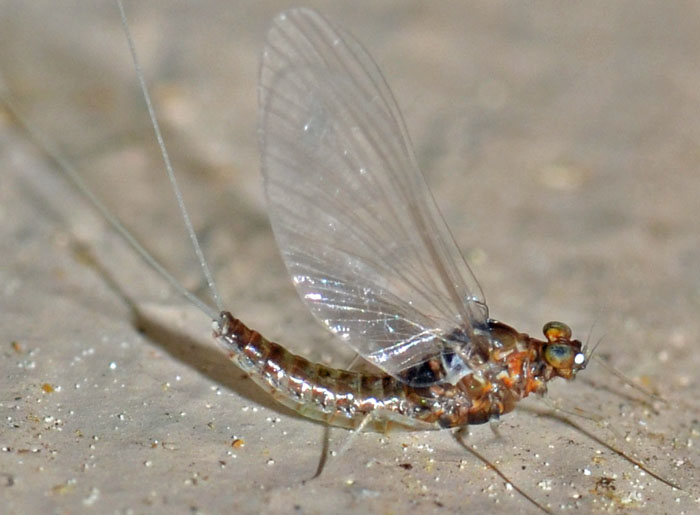 Plauditus (?) . | This Small Minnow Mayfly is a female imago that possibly belongs to the genus Plauditus. The word "imago" refers the last stage of an insect during its metamorphosis. Depending on the species, adult mayflies live from a few minutes to a few days (German "Eintagsfliege" meaning literally one-day fly). The mouthparts and the stomach are present in adults but are not used. They have paired genitalia, i.e. the male has two penises and the female two gonopores. Often mayflies locally mature at the same time and then cover--in very large groups--every available surface. bug guide (this photo): http://bugguide.net/node/view/976339 wikipedia: http://en.wikipedia.org/wiki/Mayfly | ||
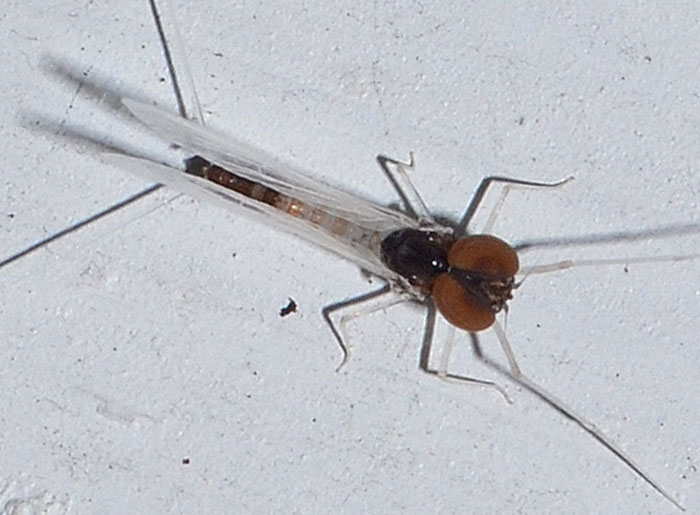 Procloeon rufostrigatum. | This Small Minnow Mayfly was an exciting find for me because the species Procloeon rufostrigatum had not yet been documented on my favorite website bugguide.net. The genus is represented by some 20 species in North America. bug guide (this photo): http://bugguide.net/node/view/1085168 | ||
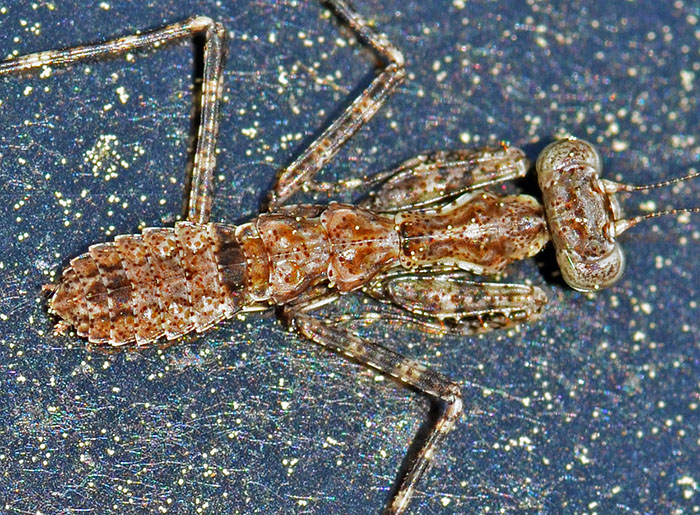 Gonatista grisea (Grizzled Mantid) - imm. | It's March and my black truck is covered by a thick layer of yellow pollen. Nonetheless, I spotted this curious, little mantid. Also known as Florida Bark Mantid, this species makes its home in the Southeastern US, Puerto Rico, Cuba, and Jamaica. As the latter name suggests, it is arboreal (tree dwelling), nymphs are wingless, and adults have a length of about 3.5-4 cm. bug guide (this photo): https://bugguide.net/node/view/1496971 UF: http://entnemdept.ufl.edu/creatures/misc/grizzled_mantid.html | ||
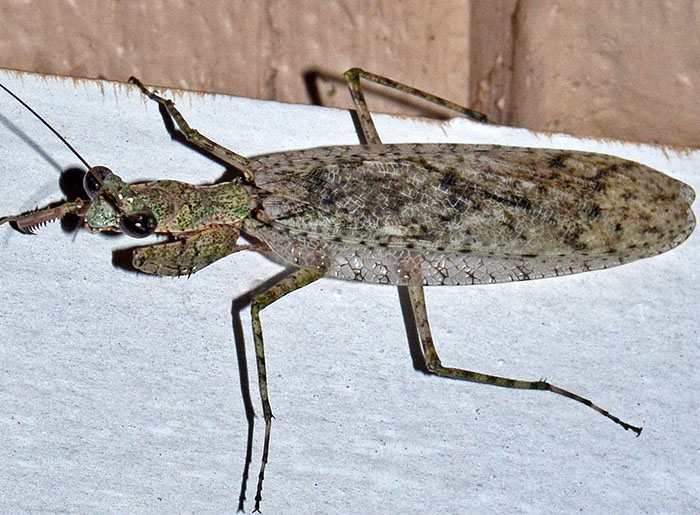 Gonatista grisea (Grizzled Mantid) ♂. | And here is an adult male of the Grizzled Mantid. It was really one of the biggest insects that I have seen in my yard but it sat rather peacefully near our porch light and looked at me. This mantid species is mottled gray, green and brown. Its overall shape is broad and flattened. The pronotum does not narrow ahead of the place where the front legs are attached. Females have short wings, whereas in males at rest the wings cover the abdomen. bug guide (this photo): https://bugguide.net/node/view/1585612 UF: http://entnemdept.ufl.edu/creatures/misc/grizzled_mantid.html | ||
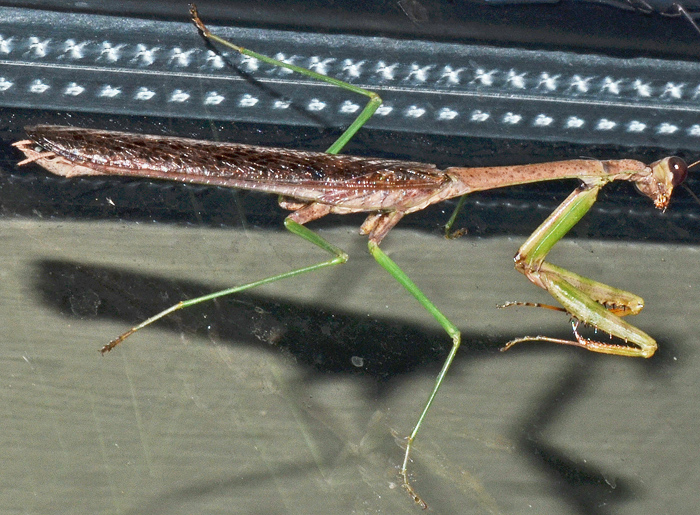 Stagmomantis carolina (Carolina Mantis) ♂. | The State insect of South Carolina: the impressive Carolina Mantis! In case you wonder about the other 49 states, check out the second link. In this species, the head and the thorax are almost as long as the body. Moreover, its antennae are about half as long as the middle legs (not shown in photos). Males are usually brown, whereas females are green or brown.
bug guide (this photo): http://bugguide.net/node/view/1138090 wikipedia (list of US state insects): https://en.wikipedia.org/wiki/List_of_U.S._state_insects | ||
 Stagmomantis sp.. | Stagomantis has six North American species: californica, carolina, floridensis, gracilipes, limbata, and venusta. Mantids are rather sedentary and may spend their whole lives on one tree as long as there is a good supply of food. In late summer males look for potential mates. They fly more than females and usually at night. Also notice the interesting patterns on the chain-link fence (see photo below).
bug guide: http://bugguide.net/node/view/4820 | ||
 Thesprotia graminis (Grass-Like Mantis). | This praying mantis looks quite similar to a walkingstick insect. Females of this species can get as large as 7 cm; males are smaller but have long wings which make them good fliers. Thesprotia graminis can be found throughout the Southern US. It is sometimes attracted by light (possibly to find small insect prey). Adults are mature by late summer and usually die by winter.
bug guide (this photo): http://bugguide.net/node/view/557322 | ||
 Chauliodes rastricornis (Spring Fishfly) ♀. | Chauliodes rastricornis is a fishfly and can be easily distinguished from dobsonflies by the presence of antennae and jaws (mandibles). This is a large, striking insect. Adult fishflies seemingly do not feed and can be found close to slow moving bodies of water. Females have nearly linear antennae (see photo) whereas males have thick, comb-like ones.
bug guide (this photo): http://bugguide.net/node/view/982460 | ||
 Chauliodes rastricornis (Spring Fishfly) ♂. | In Florida, Spring Fishflies can be found all year, while further north they are typically found in late Spring. Males (e.g this specimen) have pectinate antennae, whereas females have serrate antennae that seem quite plain by comparison.
bug guide (this photo): http://bugguide.net/node/view/10784874 | ||
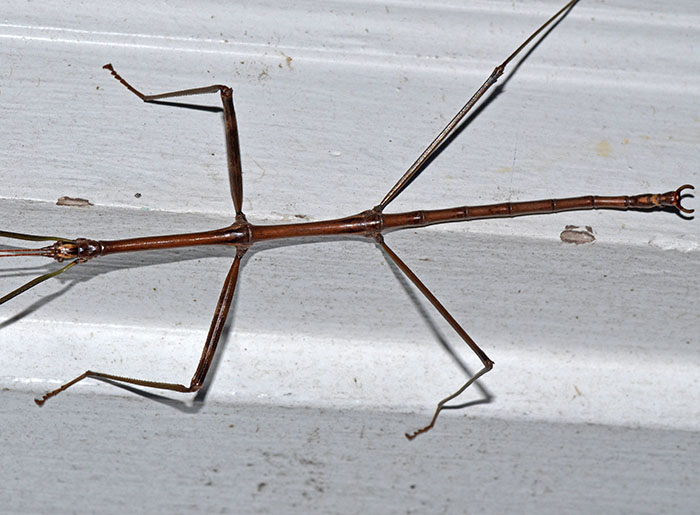 Diapheromera femorata (Northern Walkingstick) ♂. | The body of this twig-like walkingstick measures about 7.5 cm or 3 inches; the slightly greenish females can add another 2 cm to this and the antennae span about 2/3 of the length of the body. They can be found in deciduous woods or like this specimen right next to the house door. The insects have no wings and dispersal from tree to tree is limited.
bug guide (these photos): https://bugguide.net/node/view/1589062 U Michigan: http://animaldiversity.org/accounts/Diapheromera_femorata/ | ||
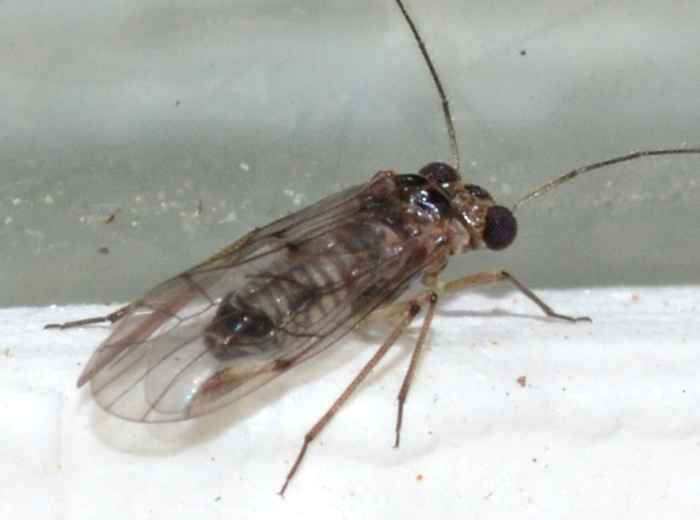 Blaste sp. (Barklouse (nonspec.) ) ♂. | This fascinating insect is a common barklouse. An expert (Prof. Mockford) identified it as Blaste sp. The genus has 12 species in North America. Barklice feed on fungi, algae, dead plant tissues etc. and are hence harmless, perhaps even beneficial to the trees they infest.
bug guide (these photos): http://bugguide.net/node/view/576977 wikipedia: http://en.wikipedia.org/wiki/Psocoptera | ||
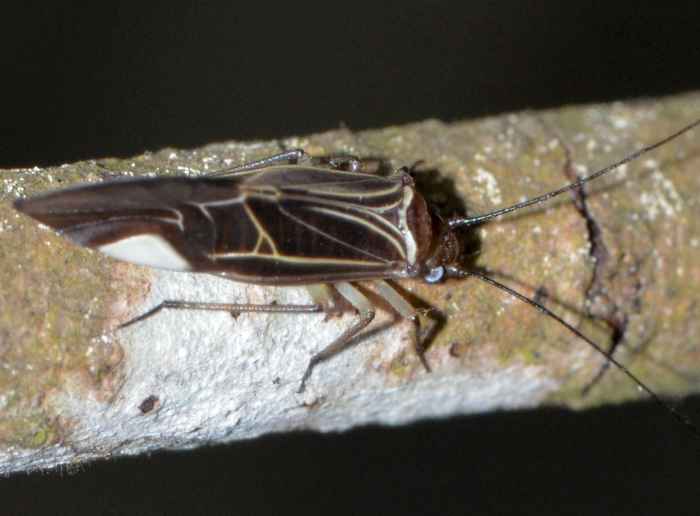 Cerastipsocus venosus. | Looks a bit like a cricket but actually belongs to the common barklice. It's Cerastipsocus venosus which is rather widespread in the Eastern US. I found this one on a pine twig. They feed on lichen. The abdomens of the species' nymphs have yellow and brown stripes . bug guide (this photo): http://bugguide.net/node/view/627877 | ||
 Hemipsocus chloroticus. | This cool little beast belongs to the family Hemipsocidae (Leaf Litter Barklice) which (in the US) has only this one genus and two species. Its range in North America seems to be limited to the Southeast and Texas. I was told that this specimen is likely a female. bug guide (this photo): http://bugguide.net/node/view/976336 | ||
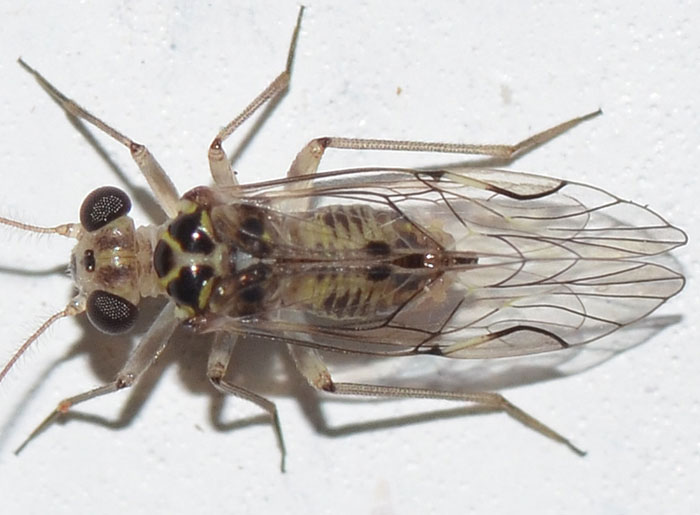 Metylophorus purus (Common Bark Louse) ♂. | I think that this common bark louse looks amazing. It's like a mix of scifi and halloween. The genus has three species in North America and about 50 worldwide. Its habitat ranges from the trunks of conifers to fence posts and house walls. This specimen sat on our window frame and must have been attracted by the light. Please take a moment and click on the photo to see a larger version. The small photo was taken on 08/30/18.
bug guide (this photo): http://bugguide.net/node/view/147329 bug guide (small photo): https://bugguide.net/node/view/1584050 | ||
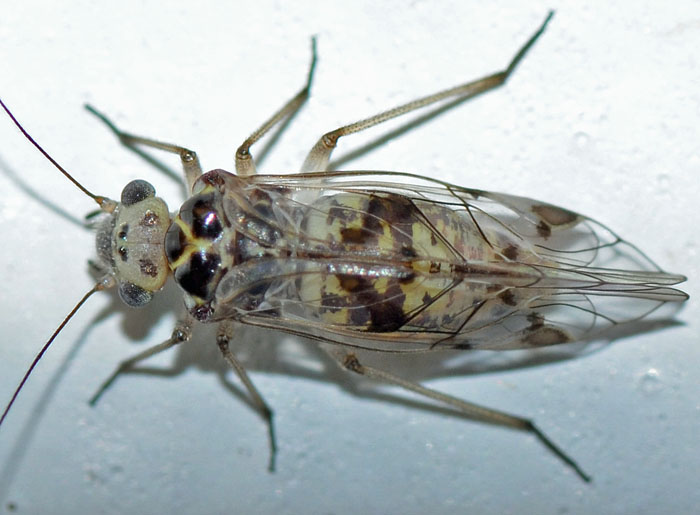 Metylophorus novaescotiae. | Metylophorus novaescotiae is another awesome barklouse. It lives on branches of broadleaf and conifer trees as well as certain shrubs. The markings on the wings of this species can be quite variable but it is one of the only Psocidae species in our region with a dark mark on the very tip of the forewing. Another diagnostic feature are apparently the four spots on the head. Click here for a high-resolution version of the photo.
bug guide (this photo): http://bugguide.net/node/view/997659 | ||
 Oecetis sp.. | Long-horned caddisflies are difficult to identify. All adults in this family have very long and slender antennae. Their larvae are aquatic. This specimen was attracted to the lights at our house. bug guide (this photo): http://bugguide.net/node/view/939499 |

